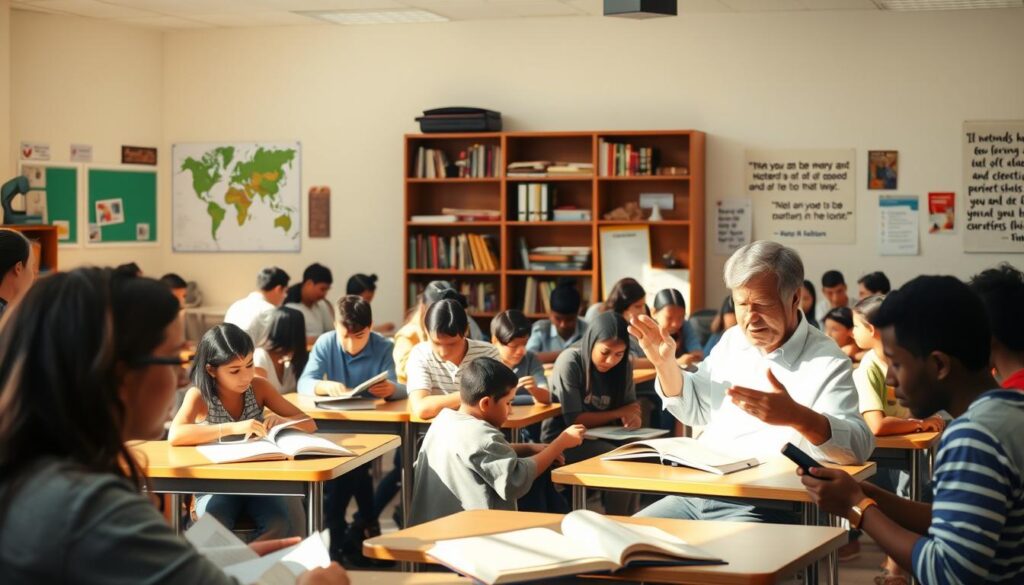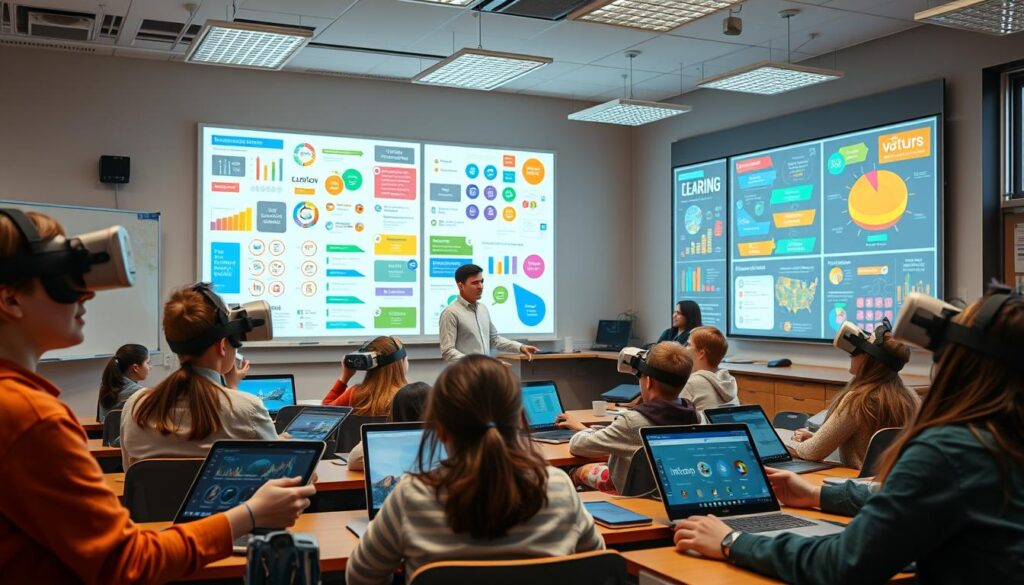Did you know that there are over 1,423 active global Open Access journals available through Education Source, a comprehensive database designed to support the diverse needs of students, professionals, and policymakers alike? This vast array of educational resources is crucial in today’s information age, facilitating informed decision-making and fostering a culture of continuous learning.
The landscape of educational resources is vast and varied, encompassing online courses, research databases, and a plethora of digital tools. For instance, platforms like Coursera and edX offer a wide range of courses from top universities, while resources like World Civil Society provide insights into free resources for learning specific subjects like civil engineering.
Key Takeaways
- Access to over 1,423 active global OA journals through Education Source.
- A variety of online courses available on platforms like Coursera and edX.
- Utilization of free resources for learning specific subjects.
- Importance of research databases for informed decision-making.
- Diverse digital tools supporting continuous learning.
Introduction to Educational Resources
As education becomes increasingly institutionalized, the role of educational resources is gaining prominence. The way people learn is undergoing a significant shift, with a growing emphasis on making education more accessible and effective.
Importance of Accessible Education
Accessible education is crucial for fostering a knowledgeable and skilled society. Online learning resources have made it possible for learners to access quality education from anywhere in the world. This accessibility is key to bridging the educational divide and ensuring that everyone has the opportunity to learn and grow.
The importance of accessible education extends beyond individual benefits, contributing to a more informed and productive community. By leveraging academic resources, educational institutions can enhance the learning experience, making it more engaging and effective.
Overview of Target Audiences
Educational resources cater to a diverse range of learners, including students, professionals, and policymakers. Each of these groups has unique needs and requirements. For instance, students require resources that support their curriculum and help them develop new skills.
Professionals, on the other hand, need resources that can aid in their continuing education and professional development. Policymakers require access to research and data that can inform their decisions on educational policy and reform.
Role of Technology in Education
Technology plays a pivotal role in modern education, enabling the creation and dissemination of educational resources. Online platforms and digital tools have made it possible to reach a wider audience, providing learners with flexible and personalized learning experiences.
The integration of technology in education also facilitates the development of innovative learning methods, such as gamification and virtual classrooms. These advancements are transforming the educational landscape, making learning more engaging and accessible.
Educational Resources for Students

Educational resources for students have evolved significantly, offering a range of tools and materials to support their academic journey. With the vast array of resources available, students can now access a wealth of information to enhance their learning experience.
Online Courses and Platforms
Online courses have become increasingly popular, providing students with the flexibility to learn at their own pace. Platforms such as Coursera, edX, and Khan Academy offer a wide range of courses on various subjects, from science and technology to humanities and social sciences. These platforms often partner with top universities, ensuring that the content is of high quality and relevance.
- Coursera: Offers a variety of courses and specializations.
- edX: Provides access to courses from leading institutions.
- Khan Academy: Focuses on free, high-quality education for all.
Open Educational Resources (OER)
Open Educational Resources (OER) are freely accessible, openly licensed materials that can be used for teaching, learning, and research. OER include textbooks, courses, and other educational materials that can be adapted and shared. The use of OER can significantly reduce costs for students and provide them with high-quality learning resources.
For more information on OER, you can visit EBSCO’s Education Subject Page, which offers a wealth of information on educational resources, including research databases like Academic Search Ultimate and Education Source.
Tools for Collaborative Learning
Collaborative learning is an essential aspect of modern education, and there are numerous tools available to facilitate this. Tools like Slack, Trello, and Google Workspace enable students to work together on projects, share resources, and communicate effectively. These tools help foster a sense of community and teamwork, which is crucial for academic success.
Financial Aid Information
Navigating financial aid can be challenging, but there are resources available to help. Students can explore federal grants, scholarships, and student loans to fund their education. Understanding the different types of financial aid and their eligibility criteria is crucial for making informed decisions.
Some key resources for financial aid include the Federal Student Aid website and the College Board’s financial aid tools. These resources provide comprehensive information on available aid options and application processes.
Supportive Resources for Professionals
Professionals seeking to enhance their skills and knowledge can leverage a variety of supportive resources. In a rapidly evolving job market, staying updated with the latest trends and technologies is crucial.
Continuing Education Options
Continuing education is vital for professionals aiming to advance in their careers. Options include online courses, certification programs, and degree programs that cater to various professional needs. For instance, platforms like the Institute for Learning Innovation offer insights into innovative learning practices.
These programs are designed to be flexible, allowing professionals to balance work and study. They cover a wide range of fields, from technology and healthcare to business and education.
Best Practices for Professional Development
Effective professional development involves setting clear goals, seeking feedback, and embracing lifelong learning. Professionals should identify areas for improvement and pursue relevant training or mentorship. Networking with peers and industry leaders is also a key aspect of professional growth.
Moreover, staying abreast of industry trends through publications, webinars, and conferences can provide valuable insights and opportunities for advancement.
Webinars and Online Workshops
Webinars and online workshops have become increasingly popular as tools for professional development. They offer a convenient way to learn from experts and network with other professionals without the need for travel. Topics range from technical skills to soft skills like leadership and communication.
These online events are often interactive, allowing participants to engage with the material and ask questions in real-time. They can be a valuable resource for professionals looking to expand their skill set or stay current with industry developments.
Policymakers and Educational Improvement

Research and data-driven insights are essential tools for policymakers aiming to improve educational outcomes. By leveraging comprehensive research reports, detailed case studies, and sophisticated data analysis tools, policymakers can make informed decisions that positively impact the education system.
Research Reports on Education Policy
Access to thorough research reports is vital for understanding the complexities of education policy. Resources like the Education Resources Information Center (ERIC) provide a wealth of information on various educational topics, from early childhood education to higher education policy. ERIC’s vast database includes research reports, conference papers, and other relevant documents that can inform policy decisions.
Case Studies of Successful Programs
Case studies offer valuable insights into the effectiveness of different educational programs and policies. By examining successful initiatives, policymakers can identify best practices and strategies that have been proven to work. For instance, a case study on a literacy program might reveal key factors contributing to its success, such as early intervention and community engagement.
“The most effective educational policies are those grounded in evidence and tailored to the specific needs of the community.”
Tools for Data-Driven Decision Making
Data-driven decision making is crucial in education policy, enabling policymakers to assess the effectiveness of current policies and make adjustments as needed. Tools that provide data analytics and visualization can help policymakers understand complex data sets and make more informed decisions. Data analysis software can facilitate the examination of student performance, demographic trends, and other critical factors in education.
- Data analytics platforms
- Statistical software
- Geographic information systems (GIS) for educational planning
By combining research reports, case studies, and data-driven insights, policymakers can develop comprehensive and effective education policies that drive positive change.
Digital Literacy and Learning Tools
The digital age has transformed the way we learn, making digital literacy a crucial skill for students and professionals alike. As we navigate through the vast array of digital resources available today, it’s essential to understand the tools that can enhance our learning experience.
Importance of Digital Literacy in Education
Digital literacy is not just about being able to use a computer or a smartphone; it’s about having the skills to effectively navigate, evaluate, and create information using digital technologies. This skillset is vital in today’s educational landscape, where technology plays a significant role in delivering educational content. For professionals, being digitally literate means staying competitive in a rapidly changing job market. Online courses are a great resource for enhancing digital literacy and professional skills.
Recommended Apps for Learning
There are numerous apps designed to enhance learning and promote digital literacy. Some of the most effective include:
- Duolingo: A language-learning app that gamifies the learning process.
- Khan Academy: Offers a wide range of free courses on various subjects.
- Coursera: Partners with top universities to offer courses on a variety of topics.
These apps not only provide educational content but also help users develop their digital skills.
E-books and Online Libraries
The rise of digital publishing has made it easier than ever to access a vast array of educational materials. E-books and online libraries offer:
| Resource | Description | Access |
|---|---|---|
| Project Gutenberg | Free e-books, mostly classics | Free |
| Google Books | Vast collection of books, some previewable | Free/Subscription |
| ManyBooks | Large collection of free e-books | Free |
These resources are invaluable for both students and professionals looking to expand their knowledge on various subjects.
In conclusion, digital literacy is a key component of modern education, and there are many tools available to support learning and professional development. By leveraging these resources, individuals can enhance their skills and stay ahead in their respective fields.
Community and Peer Support Initiatives

The importance of community and peer support in education cannot be overstated, as it fosters a collaborative learning environment. According to the Institute for Learning Innovation, free-choice learning is a significant aspect of educational development.
Study Groups and Peer Tutoring
Study groups and peer tutoring are effective methods for enhancing understanding and retention of material. These collaborative learning strategies allow students to engage with course content in a more interactive and supportive setting.
Benefits of Study Groups:
- Improved understanding through discussion
- Enhanced retention of material
- Development of teamwork and communication skills
Community Learning Centers
Community learning centers provide a valuable resource for individuals seeking to continue their education in a supportive environment. These centers often offer a range of services, including access to educational resources and facilities.
| Services | Description |
|---|---|
| Educational Resources | Access to textbooks, online courses, and study materials |
| Facilities | Study areas, computer labs, and meeting rooms |
Networking Opportunities for Professionals
Networking opportunities are crucial for professionals looking to advance their careers. Conferences, workshops, and online forums provide platforms for connecting with peers and industry leaders.
The benefits of professional networking include:
- Access to new career opportunities
- Exchange of ideas and best practices
- Potential for collaborations and partnerships
Assessments and Evaluation Tools
The effectiveness of educational programs relies heavily on the assessments and evaluation tools used to measure student learning outcomes. These tools not only help educators gauge student understanding but also inform instruction and drive improvement.
Standardized Testing Resources
Standardized testing is a traditional method of assessment that allows for comparisons across different student populations. Resources like the Mental Measurements Yearbook are invaluable for educators seeking to understand the validity and reliability of various assessments.
Key Resources for Standardized Testing:
- Mental Measurements Yearbook
- Educational Testing Service (ETS)
- College Board
Alternative Assessment Methods
As education evolves, so too do the methods of assessment. Alternative assessment methods, such as project-based evaluations and competency-based progression, offer a more nuanced view of student abilities.
Some examples include project-based assessments, competency-based progression, and self-assessment rubrics. These methods provide a more comprehensive picture of student learning.
Feedback Tools for Educators
Feedback is a critical component of the educational process, allowing educators to adjust their teaching strategies to better meet student needs. Various tools and technologies can facilitate the feedback process.
| Tool | Description | Benefit |
|---|---|---|
| Turnitin | Plagiarism detection and feedback tool | Improves academic integrity and provides detailed feedback |
| Canvas | Learning management system with feedback capabilities | Streamlines the feedback process and enhances student engagement |
| Gradebook | Tool for tracking student grades and providing feedback | Helps educators manage student performance and identify areas for improvement |
By leveraging these assessments and evaluation tools, educators can create a more effective and responsive educational environment.
Lifelong Learning Resources

Lifelong learning is no longer a choice but a necessity for personal and professional growth. In today’s rapidly changing world, individuals need to continually update their skills and knowledge to remain relevant.
Resources for Adult Learners
Adult learners have a variety of resources available to them, including online courses, vocational training, and academic programs designed specifically for adults. Education Research Complete is a valuable database that provides access to a wide range of educational research and resources.
Some popular resources include:
- Online platforms like Coursera and edX
- Vocational training programs
- Adult education centers
Online Learning Communities
Online learning communities offer a supportive environment where learners can connect, share ideas, and collaborate on projects. These communities are invaluable for adult learners who need flexibility in their learning schedules.
Tips for Balancing Work and Study
Balancing work and study requires effective time management and a clear plan. Here are some tips:
- Set clear goals and priorities
- Create a study schedule
- Communicate with your employer and family
| Resource | Description | Benefits |
|---|---|---|
| Coursera | Online learning platform | Flexible, wide course selection |
| edX | Massive Open Online Courses | High-quality courses, certificates |
| Vocational Training | Practical skill development | Job-ready skills, hands-on experience |
Government and Nonprofit Resources
The landscape of educational support is significantly enhanced by government and nonprofit initiatives. These organizations provide a wide array of resources that are crucial for the development of education.
Federal Grants for Education
Federal grants play a vital role in supporting educational projects and initiatives. These grants are often allocated based on specific criteria, such as the need for educational improvement or the implementation of innovative teaching methods.
- Types of Grants: There are various types of federal grants available, including those for research, infrastructure development, and program implementation.
- Application Process: The application process typically involves submitting a detailed proposal outlining the project’s objectives, methodology, and budget.
Nonprofit Organizations Supporting Education
Nonprofit organizations are another significant source of support for education. They often focus on specific areas, such as literacy, STEM education, or supporting disadvantaged students.
- Some notable nonprofit organizations include the Bill and Melinda Gates Foundation and the Lumina Foundation.
- These organizations provide funding, resources, and expertise to educational institutions and programs.
Educational Policy Initiatives
Government and nonprofit organizations also influence educational policy through various initiatives. These initiatives aim to improve educational outcomes and address systemic issues within the education system.
- Policy Research: Research is conducted to inform policy decisions, often involving the analysis of data and best practices.
- Advocacy: Organizations advocate for policy changes that support educational improvement.
By leveraging these resources, educational institutions and stakeholders can access the support they need to enhance educational quality and accessibility.
Incorporating Technology in Learning

Educational technology is playing an increasingly vital role in enhancing the learning experience. By leveraging technology, educators can create more engaging, interactive, and effective learning environments.
Educational Software and Applications
Educational software and applications have become indispensable tools in modern classrooms. They offer a range of benefits, including personalized learning experiences, real-time feedback, and access to a vast array of educational resources. For instance, tools like Khan Academy and Coursera provide high-quality educational content for professionals looking to enhance their skills.
Key Features of Educational Software:
- Interactive learning modules
- Adaptive assessments
- Collaboration tools
Virtual Classrooms and Learning Management Systems
Virtual classrooms and Learning Management Systems (LMS) have transformed the way educational content is delivered. Platforms like Canvas and Blackboard enable educators to manage coursework, communicate with students, and track progress in a centralized online environment. These systems support both synchronous and asynchronous learning, making education more accessible.
Benefits of Virtual Classrooms:
- Flexibility in scheduling
- Access to global educational resources
- Enhanced student engagement
Gamification in Education
Gamification involves the use of game design elements in educational contexts to increase engagement and motivation. By incorporating elements like points, badges, and leaderboards, educators can make learning more enjoyable and interactive. This approach is particularly effective in subjects that require problem-solving and critical thinking.
Examples of Gamification in Education:
| Platform | Description | Subject Area |
|---|---|---|
| Duolingo | Language learning through gamified exercises | Languages |
| CodeCombat | Learning programming concepts through game-like challenges | Computer Science |
| Classcraft | Classroom management system that gamifies student behavior | Classroom Management |
By embracing these technologies, educators can create more dynamic and effective learning environments that cater to the diverse needs of their students.
Innovative Teaching Strategies
Educators are continually seeking new methods to enhance student learning, and innovative teaching strategies are at the forefront of this pursuit. By adopting these strategies, educators can create a more engaging and effective learning environment.
Project-Based Learning Resources
Project-based learning (PBL) is an instructional approach that encourages students to learn and develop skills through real-world projects. Active learning initiatives often incorporate PBL to foster deeper understanding and application of knowledge.
- Resources for implementing PBL include online platforms and curriculum guides.
- Examples of successful PBL projects demonstrate its potential in enhancing student engagement.
Blended Learning Techniques
Blended learning combines traditional teaching methods with online learning. This approach allows for a more personalized learning experience.
| Technique | Description | Benefits |
|---|---|---|
| Flipped Classroom | Students learn at home through online content and work on activities in the classroom. | Increased interaction, personalized attention |
| Rotation Model | Students rotate between online learning and traditional classroom settings. | Flexibility, self-paced learning |
Student-Centered Learning Approaches
Student-centered learning focuses on the needs, abilities, and interests of students, making learning more relevant and engaging.
Key Strategies:
- Personalized learning plans tailored to individual students.
- Encouraging student autonomy and self-directed learning.
By incorporating these innovative teaching strategies, educators can enhance academic resources for students, making education more accessible and effective.
Mental Health and Wellness Support

Mental health support has become a critical component of the educational experience, ensuring students have the resources they need to succeed.
Educational institutions are increasingly recognizing the importance of providing comprehensive support systems for their students. This includes not only academic support but also resources to help manage mental health and wellness.
Counseling Resources for Students
Counseling services are a vital part of mental health support in educational settings. Many institutions offer free or low-cost counseling sessions to students, providing a safe space to discuss their concerns and receive guidance.
Some recommended counseling resources include:
- National Alliance on Mental Illness (NAMI) Helpline
- Crisis Text Line (text “HOME” to 741741)
- Local mental health clinics and therapists
Stress Management Workshops
Stress management is crucial for students to maintain their mental health and academic performance. Workshops and seminars on stress management techniques, such as mindfulness and meditation, are becoming increasingly popular.
“Mindfulness is the practice of being present in the moment, without judgment. It has been shown to reduce stress and improve overall well-being.”
Some effective stress management techniques include:
- Deep breathing exercises
- Physical activity and exercise
- Journaling and expressive writing
Wellness Programs in Schools
Wellness programs in schools aim to promote healthy lifestyles among students, including physical activity, healthy eating, and mental health awareness.
| Program | Description | Benefits |
|---|---|---|
| Fitness Classes | Regular exercise sessions for students | Improved physical health, reduced stress |
| Nutrition Workshops | Educational sessions on healthy eating | Better nutrition, improved energy levels |
| Mental Health Awareness | Campaigns to reduce stigma around mental health | Increased understanding and support for mental health issues |
By incorporating these resources and programs, educational institutions can provide comprehensive support for students’ mental health and wellness, enhancing their overall educational experience.
Accessibility Resources in Education
Accessibility in education is not just a necessity, but a fundamental right for all students. Ensuring that educational resources are accessible to everyone, regardless of their abilities, is crucial for creating an inclusive learning environment.
Tools for Students with Disabilities
Various tools and technologies are available to support students with disabilities. These include text-to-speech software, screen readers, and adaptive keyboards. Such tools help students with disabilities to access educational content and participate fully in learning activities.
For instance, study guides can be made available in digital formats that are compatible with screen readers, ensuring that visually impaired students can access the same information as their peers.
Inclusive Teaching Strategies
Inclusive teaching strategies are essential for creating a learning environment that supports all students. Teachers can adopt various methods, such as differentiated instruction and universal design for learning (UDL), to cater to diverse learning needs.
By incorporating career development tools into their teaching practices, educators can help students explore potential career paths and develop relevant skills.
Legal Framework for Accessibility
The legal framework supporting accessibility in education is robust, with laws such as the Americans with Disabilities Act (ADA) and the Individuals with Disabilities Education Act (IDEA) providing guidelines and protections for students with disabilities.
Educational institutions must comply with these laws, ensuring that their programs and resources are accessible to all students. This includes providing reasonable accommodations and ensuring that digital resources are accessible.
Global Educational Resources

The landscape of education is being transformed by global educational resources that promote international collaboration and knowledge sharing. As educational institutions and policymakers look beyond their national borders, they are discovering the value of global perspectives in enhancing the quality and relevance of education.
International Collaborations in Education
International collaborations in education are on the rise, driven by the need for shared knowledge, research, and innovation. These collaborations enable institutions to pool their resources, expertise, and experiences, creating richer educational environments. For instance, the European Union’s Erasmus program has facilitated student and staff mobility across member states, promoting cultural exchange and academic collaboration.
Such collaborations are not limited to Europe; global initiatives like the Association of Pacific Rim Universities (APRU) bring together universities from around the Pacific to foster academic collaboration, research, and innovation. These programs underscore the importance of global partnerships in education.
Learning from Global Educational Practices
Learning from global educational practices is crucial for identifying best practices and areas for improvement. By examining how different countries approach education, policymakers and educators can gain insights into effective strategies for enhancing student outcomes. For example, countries like Finland and Singapore have been recognized for their innovative approaches to education, which have led to significant improvements in their educational systems.
“The key to successful education reform is not to adopt a one-size-fits-all approach but to understand the cultural, social, and economic contexts that shape educational outcomes.” –
Cross-Cultural Exchange Programs
Cross-cultural exchange programs are a vital component of global educational resources, offering students, educators, and researchers the opportunity to engage with different cultures and educational systems. These programs not only enrich the participants’ educational experiences but also foster global understanding and cooperation.
| Program | Description | Benefits |
|---|---|---|
| Fulbright Program | A U.S. cultural exchange program that offers grants for international educational exchange. | Cultural immersion, academic collaboration, professional development |
| Erasmus Mundus | A European Union program that supports international student mobility and academic cooperation. | Enhanced academic experience, cultural diversity, global networking |
| AFS Intercultural Programs | A global organization that offers cultural exchange programs for students and young people. | Personal growth, intercultural understanding, global citizenship |
By leveraging global educational resources, including international collaborations, learning from global practices, and cross-cultural exchange programs, the educational community can work together to address common challenges and create a more inclusive, effective, and globally connected educational landscape.
Future Trends in Education
The education landscape is on the cusp of a revolution, driven by advancements in EdTech and AI. As we look to the future, it’s essential to understand the trends that will shape the way we learn and teach.
According to a report by HolonIQ, global education technology investments reached $18.1 billion in 2020, highlighting the growing importance of technology in education. This trend is expected to continue, with innovations in AI, virtual reality, and blockchain changing the educational landscape.
Predictions for EdTech Developments
EdTech is rapidly evolving, with several key trends emerging. These include:
- Personalized learning platforms that use AI to tailor education to individual students’ needs.
- Virtual and augmented reality technologies that create immersive learning experiences.
- Blockchain-based systems for secure and transparent credentialing.
As noted by
“The future of education lies in its ability to adapt to the needs of the individual learner, and EdTech is at the forefront of this revolution.”
The Role of Artificial Intelligence in Learning
AI is transforming education by providing personalized learning experiences, automating grading, and enhancing student engagement. AI-powered adaptive learning systems adjust to the individual student’s pace, providing real-time feedback and recommendations for improvement.
A study by the Rand Corporation found that AI-based learning tools can significantly improve student outcomes, particularly for those who are struggling.
| AI Application | Benefit |
|---|---|
| Personalized Learning | Tailors education to individual needs |
| Automated Grading | Frees up instructors’ time for more critical tasks |
| Enhanced Engagement | Improves student participation and motivation |
Adapting to Changing Workplace Needs
The modern workplace is undergoing rapid changes due to technological advancements and shifting economic conditions. Education must adapt to prepare students for these changes.
This involves:
- Developing skills that are complementary to automation, such as critical thinking and creativity.
- Providing training in emerging technologies like data science and AI.
- Fostering lifelong learning skills to enable professionals to continuously update their knowledge and skills.
By focusing on these areas, education can play a crucial role in preparing the workforce for the challenges and opportunities of the future.
Conclusion: Empowering Through Education
Education is a powerful tool that empowers individuals, communities, and societies as a whole. The educational resources available to students, professionals, and policymakers play a crucial role in shaping the future.
Stakeholder Engagement
Stakeholders in education, including educators, administrators, and policymakers, must work together to ensure that these resources are utilized effectively. By doing so, they can create a more inclusive and equitable education system.
Continuous Learning
The importance of continuous learning cannot be overstated. As the landscape of education continues to evolve, it is essential that individuals and organizations remain committed to ongoing professional development and skill-building.
Better Tomorrow
By leveraging educational resources and promoting a culture of continuous learning, we can build a brighter future for all. This future is characterized by a well-educated population, equipped with the skills and knowledge necessary to succeed in an increasingly complex world.
Educational resources for students, professionals, and policymakers are essential in achieving this vision. By working together and embracing the power of education, we can create a more just and prosperous society.
